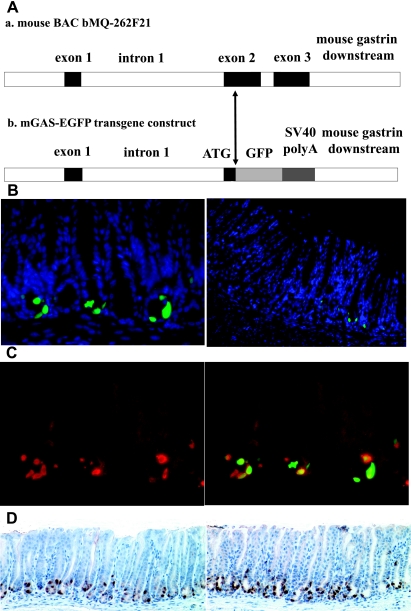Fig. 1.
Characterization of the mouse gastrin gene and the transgene construct of bacterial artificial chromosome (BAC) transgenic murine gastrin-promoter enhanced green fluorescent protein (EGFP) reporter (mGAS-EGFP) mice and the expression of green fluorescent protein (GFP) signals in the antrum and the transitional zone of mGAS-EGFP mice. A: genomic segment encompassing the mouse gastrin gene locus is represented as a horizontal line. Exons are represented as filled boxes and introns are unshaded. The transgene construct of mGAS-EGFP mice is created by replacing the open reading frame of the mouse gastrin gene, located in the 2nd and 3rd exons, after the ATG start codon with the EGFP cDNA-SV40polyA-PGK-neomycin cassette by using the BAC recombineering technology, followed by the removal of PGK-neomycin cassette with arabinose-induced Flpe recombinase gene. B: GFP expression in the gastric antrum and corpus of mGAS-EGFP mice. Left: merged image of GFP signals and 4′,6-diamidino-2-phenylindole (DAPI) staining in the gastric antrum (magnification: ×400). Right: merged image of GFP signals and DAPI staining from the gastric corpus to the transitional zone (magnification: ×200). Many GFP-positive cells were detected in the gastric antrum, whereas there were few positive cells in the transitional zone and no positive cells in the corpus. C: immunohistochemical staining with anti-amidated gastrin antibody in the antrum. Anti-amidated gastrin immunostaining with Texas red (left) and merged image of GFP expression with anti-amidated gastrin immunostaining (right) (magnification: ×400). D: bright-field immunohistochemical staining with anti-GFP and anti-amidated gastrin antibodies in the antrum. Anti-GFP antibody immunostaining (left) and anti-amidated gastrin antibody immunostaining (right), both followed by peroxidase-conjugated secondary antibodies and diaminobenzidine staining (magnification: ×200). C and D: images indicated that most of the GFP-positive cells were also positive for gastrin immunostaining, which confirmed that these cells were indeed G cells.

